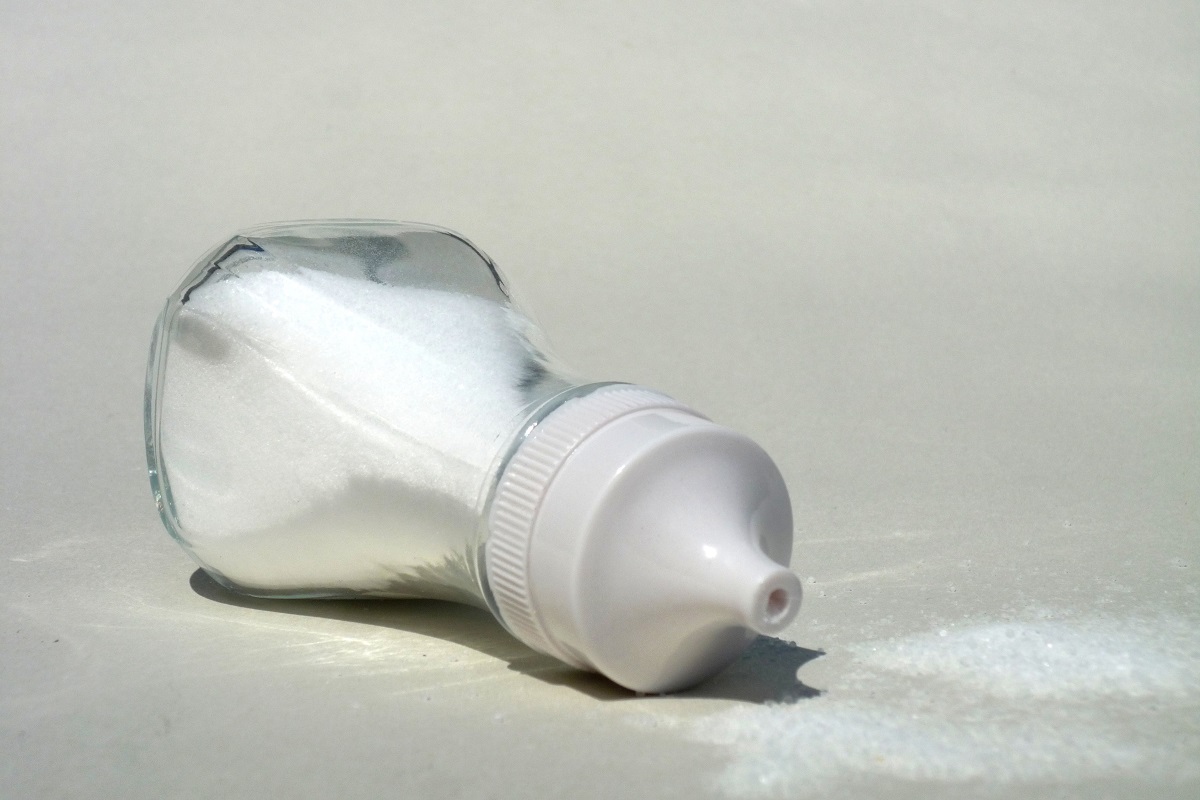Sustain / Real Bread Campaign / About / Bakery support
Salt

- The Campaign's calls
- What’s wrong with salt?
- Are some types of salt healthier than others?
- So why use salt in baking?
- What can professional bakers do?
- How to much salt to use
- What about shoppers?
- Miscellaneous
- Links
Introduction
In very small amounts, sodium (an element in common salt) plays a part in a number of functions in the human body but many people in the UK consume far more than is healthy.
As part of our work in finding ways to make bread better for us, better for our communities and better for the planet, the Real Bread Campaign urges all bakers to check if they need to reduce the amount of salt they use.
Much of the excess salt in people's diets comes from ultra-processed industrial food products, but Real Bread bakers have their part to play in baking things better, too.
Skilled Real Bread bakers are well placed to keep salt levels down as using fantastic, flavoursome, natural ingredients and longer fermentation to bring out the best in them is at the heart of what they do. There should be no need for excess salt in an attempt to enhance the flavour of low-quality flour made into dough that is given insufficient time to ripen in order to bring out what little flavour it has.
From a political (with a small p) angle, it would be hypocritical of us to point the finger at ultra processed food manufacturers without working to put our own house in order.
The Campaign's calls
In line with Public Health England’s 2024 voluntary salt reduction target for bread (and industrial loaf products) we encourage Real Bread bakers to aim for a maximum salt level in plain bread of no more than 0.85% (ie 0.85g per 100g) of finished product weight.*
We also call for:
- Mandatory standards for maximum salt content of bread served in schools, hospitals, care homes and other public sector institutions.
- Supermarket in-store bakeries and chain bakeries to give salt content information for all loaves (including thos sold unwrapped) at the point of sale.
*The target maximum for each type of plain bread is actually 1.01g salt per 100g, but we're encouraging bakers to aim for 0.85g/100g, which is the target average across the range of plain bread a company produces.
The target for morning goods (eg croissants) is slightly lower, while the target for bread with additions (such as cheese) is slightly higher.
What’s wrong with salt?
The overwhelming evidence is that a diet high in common salt (sodium chloride) contributes to high blood pressure (hypertension) which increases your risk of a number of health conditions, in particular heart disease and stroke.
Studies have also linked a high salt diet to cancer of the stomach, kidney disease, osteoporosis, kidney stones, obesity, and to exacerbating the symptoms of Meniere’s Disease, Alzheimer’s Disease and diabetes.
For these reasons, the Real Bread Campaign supports the work of Action on Salt (fka Consensus Action on Salt & Health) and Salt Awareness Week in drawing attention to these risks and finding ways to reduce the amount of salt in our diets.
Current UK governmental advice is that adults should consume no more than 6g of salt per day.
Are some types of salt healthier than others?
No.
There is no substance to claims that any particular form of salt 'tastes saltier so you use less' or is 'healthier because it contains other minerals'. These minerals are in such small quantities, you'd have to consume enormous amounts of salt to take in beneficial amounts of micronutrients, of which there are better sources anyway.
Some salt is iodised* in an effort to counteract a deficiency in some people's diets, but there are plenty of healthier sources of iodine, such as fish, seafood, seaweed, milk and other dairy products. For more information on this, click here.
That said, industrially produced salt might contain additives that you want to avoid, such as the anti-caking agent sodium hexacyanoferrate (II).
You might want to choose salt produced by a small, independently-owned business that provides more skilled work for local people per pack than an industrial producer does. You might also find certain brands have processing methods (e.g. sun-drying of sea water) that use less energy and generate lower negative environmental impacts.
* Though the Scientific Advisory Committee on Nutrition (SACN) notes that: '...iodised salt is not widely available in the UK or used in manufactured products.'
So why use any salt in baking?
In Real Bread making and industrial loaf manufacture, salt in very small quantities helps to:
- Enhance flavour*
- Strengthen the gluten network
- Aid the browning process
- Act as a natural preservative
*This is especially useful in industrial loaf production that uses highly-refined white flour and doesn’t allow enough time for the dough to ‘ripen’ and develop much flavour naturally.
What can professional bakers do?
Many industrial loaf manufacturers, 'craft' bakers (and even some Real Bread bakers) allowed salt levels in their products to creep up to unecessarily high levels and their baked goods became a major contributor to salt in our diets.* The Federation of Bakers (which represents many of the country's wrapped/sliced loaf producers) gives the figure as about 17% of the salt we consume in the UK.
Public Health England’s 2024 voluntary salt reduction target for bread (and industrial loaf products) is a maximum salt level of no more than 0.85% (ie 0.85g per 100g) of finished product weight.
Adverse publicity over the years has helped to persuade many industrial and craft bakers to lower the salt levels of their loaves and other baked goods.
FSA research has shown that reducing salt in bread is easy and acceptable to customers, with no discernible effect on taste. In the FSA study bakers reduced the level of salt in their bread by 25% over six weeks and customers did not notice the difference. Not only that, the quality of bread baked in commercial premises, under different conditions, using different recipes remained high.
The Campaign urges all Real Bread (and other) bakers to look at the salt level you are using in your loaves, and to lower it if you exceed the target maximum.
NB The target is based on finished loaf weight, not dough weight or baker’s percentage based on flour weight.
But it's not Real Bread's fault!
Much of the excess salt in people's diets comes from ultra-processed industrial food products, but Real Bread bakers have their part to play in baking things better, too.
But that amount of salt is part of a traditional recipe
For all sorts of reasons, recipes evolve over time. The type and quantity of ingredients change. 'We've always done it this way,' is not a great defence for continuing something proven to be bad for us.
How to much salt to use
Unless you're making pane Toscano, you'll probably want to use at least some salt when baking bread.
Professional bakers
We encourage all bakers to reduce the amount of salt they use to meet the 0.85% target. In terms of baker’s percentages to achieve this, the amount of salt will be approximately 1% - 1.5% of the flour weight. This depends on several other factors, including the hydration of the dough, whether or not there are other ingredients in the bread such as seeds or fruit, the surface area to volume ratio of the loaf, for how long and at what temperature it is baked.
Perhaps the simplest guide is to start from the weight you know your loaves to be once cooled and work backwards to calculate 0.85 of that as the maximum amount of salt to use.
Fulfilling the functions of salt
- Flavour can be boosted by using more flavoursome flours ( eg higher extraction / less refined, and/or different varieties or types of wheat) and enhanched by longer fermentation, particularly the sourdough process.
- Fermentation can be controlled by adjusting temperature and amount of yeast or soyrdough starter.
Home bakers
If you see a recipe based on 500g flour that asks for 2tsp, 10g (or more) salt - it's way too much! It should be more like 5g.
Here's an example recipe for a basic tin loaf of white Real Bread:
500g bread flour
300g/ml water
8g fresh (or 4g dried active) yeast
5g salt (a level 5ml teaspoon of salt weighs around 5.5-6.5g)*
= total 813g
When baked, this loaf should weigh about 650g or just over, and so should have a salt content of 0.85% or less.
What about shoppers?
For factory loaves, wraps, crumpets etc. always read the label! If the list of additives doesn’t put you off, then look out for a salt of 0.85g per 100g or less. Hopefully there'll be traffic light labelling on the front, so go for green.
For unwrapped loaves, you'll need to ask a member of shop staff for advice.
Miscellaneous
As an aside from the health issues related to salt...
What is salt rising bread?
In salt rising bread the leavening agent (i.e. the thing that produces the gas that makes the dough rise) is a halophytic (salt-loving) bacterium, yeasts or chemicals such as baking powder.
Here is an abstract of a West Virginia Medical Journal article entitled Microbiology of salt rising bread by Juckett et al:
‘Salt rising bread (SRB) is an Appalachian traditional bread made without yeast, using a starter derived from flour, milk and potatoes. The "rising agent" has been identified as Clostridium perfringens, not salt, and is presumably derived from the environment. Although no cases of illness have been attributed to SRB, C. perfringens type A is a common cause of food poisoning from meats and gravies. Other C. perfringens isolates may cause enteritis necroticans (pig-bel disease) and gas gangrene. Past research documents that pathogenic strains derived from wounds may be used to produce bread and that bacteria isolated from this bread retain their pathogenicity. SRB starter samples were cultured at the University of Pittsburgh and abundant C. perfringens, type A grew out of all samples. However none of the cultures were positive for enterotoxin and thus would be unlikely to cause human food borne disease. While this does not preclude the possibility of other starter mixes containing enteropathogenic strains, the baking process appears to reduce bacterial contamination to safe levels and SRB has not been implicated in causing any human disease.’
See also creating a stink.
External links
Salt: the facts - NHS
Salt and your health - Action on Salt
Salt and Health - Scientific Advisory Committee on Nutrition
See also
Sliced factory loaves saltier than crisps
Real Bread Campaign: The Real Bread Campaign finds and shares ways to make bread better for us, better for our communities and better for the planet. Whether your interest is local food, community-focussed small enterprises, honest labelling, therapeutic baking, or simply tasty toast, everyone is invited to become a Campaign supporter.


